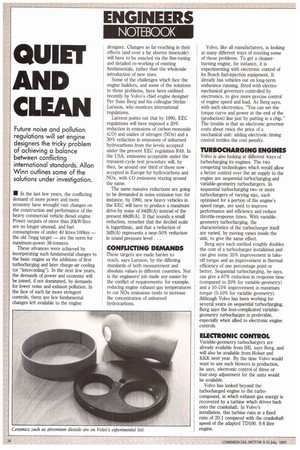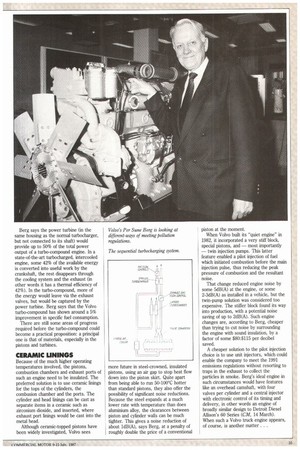Future noise and pollution regulations will set engine designers the
Page 36

Page 37

If you've noticed an error in this article please click here to report it so we can fix it.
tricky problem of achieving a balance between conflicting international standards. Allan Winn outlines some of the solutions under investigation.
• In the last few years, the conflicting demand of more power and more economy have wrought vast changes on the construction and performance of the heavy commercial vehicle diesel engine. Power outputs of more than 20kW/litre are no longer unusual, and fuel consumptions of under 40 litres/100Icm — the old 7mpg target — are the norm for maximum-power 38-tonners.
These advances were achieved by incorporating such fundamental changes to the basic engine as the additions of first turbocharging and later charge-air cooling (or "intercooling"). In the next few years, the demands of power and economy will be joined, if not dominated, by demands for lower noise and exhaust pollution. In the face of such far more stringent controls, there are few fundamental changes left available to the engine designer. Changes as far-reaching in their effects (and over a far shorter timescale) will have to be enacted via the fine-tuning and detailed re-working of existing fundamentals, rather than the wholesale introduction of new ones.
Some of the challenges which face the engine builders, and some of the solutions to those problems, have been outlined recently by Volvo's chief engine designer Per Sune Berg and his colleague Stefan Larsson, who monitors international regulations.
Larsson points out that by 1990, EEC regulations will have imposed a 20% reduction in emissions of carbon monoxide (CO) and oxides of nitrogen (NOx) and a 30% reduction in emissions of unburned hydrocarbons from the levels accepted under the present EEC regulation R49. In the USA, emissions acceptable under the transient-cycle test procedure will, by then, be around one third of those now accepted in Europe for hydrocarbons and NOx, with CO emissions staying around the same.
The same massive reductions are going to be demanded in noise emission too: for instance, by 1990, new heavy vehicles in the EEC will have to produce a maximum drive-by noise of 84dB(A) instead of the present 88dB(A). If that sounds a small reduction, remeber that the decibel scale is logarithmic, and that a reduction of 3dB(A) represents a near-50% reduction in sound pressure level. . .
CONFLICTING DEMANDS
These targets are made harder to reach, says Larsson, by the differing standards of both measurement and absolute values in different countries. Nor is the engineers' job made any easier by the conflict of requirements: for example, reducing engine exhaust-gas temperatures to cut NOx omissions tends to increase the concentration of unburned hydrocarbons. Volvo, like all manufacturers, is looking at many different ways of meeting some of these problems. To get a cleanerburning engine, for instance, it is experimenting with electronic control of its Bosch fuel-injection equipment. It already has vehicles out on long-term endurance running, fitted with electromechanical governors controlled by electronics, to give more precise control of engine speed and load. As Berg says, with such electronics, "You can set the torque curve and power at the end of the (production) line just by putting in a chip." The trouble is that an electronic governor costs about twice the price of a mechanical unit: adding electronic timing control trebles the cost penalty.
TURBOCHARGING ENGINES
Volvo is also looking at different ways of turbocharging its engines. The two competing technologies which would allow a better control over the air supply to the engine are sequential turbocharging and variable-geometry turbochargers. In sequential turbocharging two or more turbochargers of varying size, each optimised for a portion of the engine's speed range, are used to improve performance and efficiency and reduce throttle-response times. With variablegeometry turbocharging, the characteristics of the turbocharger itself are varied, by moving vanes inside the unit, to give the same effect.
Berg says each method roughly doubles the cost of a turbocharger installation and can give some 35% improvement in takeoff torque and an improvement in thermal efficiency of one percentage point or better. Sequential turbocharging, he says, can give a 67% reduction in response time (compared to 20% for variable-geometry) and a 10-15% improvement in maximum torque (5-10% for variable geometry). Although Volvo has been working for several years on sequential turbocharging, Berg says the less-complicated variablegeometry turbocharger is preferable, especially when allied to electronic engine controls.
ELECTRONIC CONTROL
Variable-geometry turbochargers are already available from 1H1, says Berg, and will also be available from Holset and KKK next year. By the time Volvo would want to use such blowers in production, he says, electronic control of three or four-step adjustment for the units would be available.
Volvo has looked beyond the turbocharged engine to the turbocompound, in which exhaust-gas energy is recovered by a turbine which drives back onto the crankshaft. In Volvo's installation, this turbine runs at a fixed ratio of 20:1 compared with the crankshaft speed of the adapted TD100, 9.6 litre engine. Berg says the power turbine (in the same housing as the normal turbocharger, but not connected to its shaft) would provide up to 50% of the total power output of a turbo-compound engine. In a state-of-the-art turbocharged, intercooled engine, some 42% of the available energy is converted into useful work by the crankshaft, the rest disappears through the cooling system and the exhaust (in other words it has a thermal efficiency of 42%). In the turbo-compound, more of the energy would leave via the exhaust valves, but would be captured by the power turbine. Berg says that the Volvo turbo-compound has shown around a 5% improvement in specific fuel consumption.
There are still some areas of progress required before the turbo-compound could become a practical proposition: a principal one is that of materials, especially in the pistons and turbines.
CERAMIC LININGS
Because of the much higher operating temperatures involved, the pistons, combustion chambers and exhaust ports of such an engine need to be insulated. The preferred solution is to use ceramic linings for the tops of the cylinders, the combusion chamber and the ports. The cylinder and head linings can be cast as separate items in a ceramic such as zirconium dioxide, and inserted, where exhaust port linings would be cast into the metal head.
Although ceramic-topped pistons have been widely investigated, Volvo sees more future in steel-crowned, insulated pistons, using an air gap to stop heat flow down into the piston skirt. Quite apart from being able to run 50-100°C hotter than standard pistons, they also offer the possibility of significant noise reductions. Because the steel expands at a much lower rate with temperature than does aluminium alloy, the clearances between piston and cylinder walls can be much tighter. This gives a noise reduction of about ldB(A), says Berg, at a penalty of roughly double the price of a conventional piston at the moment.
When Volvo built its "quiet engine" in 1982, it incorporated a very stiff block, special pistons, and — most importantly — twin injection pumps. This latter feature enabled a pilot injection of fuel which initiated combustion before the main injection pulse, thus reducing the peak pressure of combustion and the resultant noise.
That change reduced engine noise by some 5dB(A) at the engine, or some 2-3dB(A) as installed in a vehicle, but the twin-pump solution was considered too expensive. The stiffer block found its way into production, with a potential noise saving of up to 2dB(A). Such engine changes are, according to Berg, cheaper than trying to cut noise by surrounding the engine with sound insulation, by a factor of some $80:$115 per decibel saved.
A cheaper solution to the pilot injection choice is to use unit injectors, which could enable the company to meet the 1991 emissions regulations without resorting to traps in the exhaust to collect the particles in smoke. Berg's ideal engine in such circumstances would have features like an overhead camshaft, with four valves per cylinder and a central injector with electronic control of its timing and delivery, in other words an engine of broadly similar design to Detroit Diesel Allison's 60 Series (CM, 14 March). When such a Volvo truck engine appears, of course, is another matter. . .




































































































